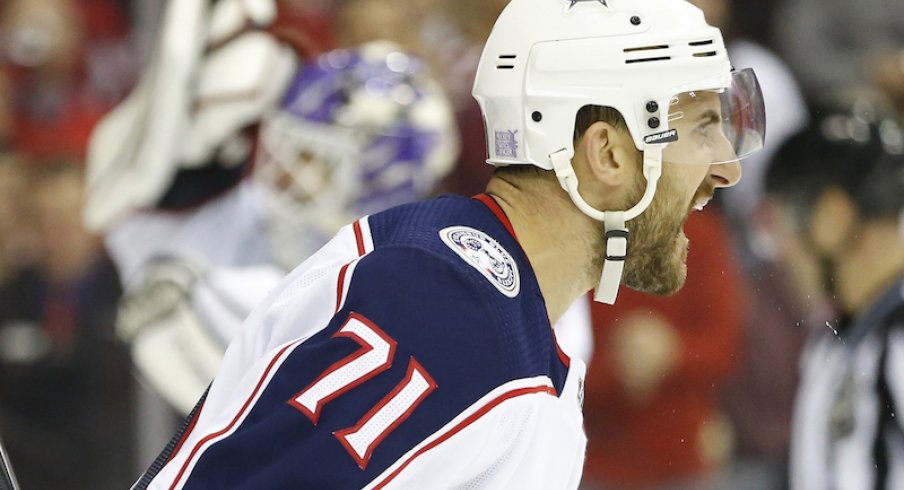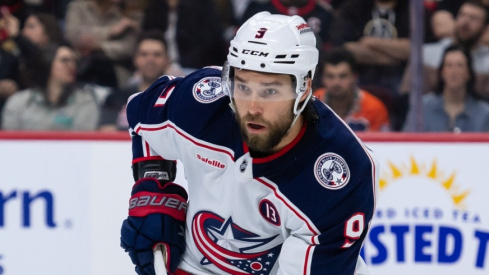The Columbus Blue Jackets woke up at the top of the Metropolitan Division – an impressive feat despite the division's overall struggles so far – and will get a chance to maintain or stretch their lead tonight against the Dallas Stars.
How did the Blue Jackets climb to the top of their division? Let's dive right in – here's what we've learned over the last week.
Power Play… Hello
After a miserable 0-for-21 stretch on the power play – one that saw them give up three shorthanded goals and take four penalties to negate those power plays – the Blue Jackets have seemingly turned a corner on the man advantage.
This unit doesn't just look passable, it's looked… surprisingly good? All of the sudden, there's plenty of crisp puck movement, intense effort when retrieving loose pucks and good chances with good finishes.
For those keeping track at home, they have at least one power play goal in each of the last three games. That'd be a footnote for many teams, but for the Blue Jackets, it's a reason for optimism. In fact, the power play was actually the sole provider of offense for the Blue Jackets in their win over the Washington Capitals.
The power play has been the biggest red flag so far in this (still young) Blue Jackets season. If it becomes a strength, the Blue Jackets could run away with the division.
Bob Can Still Be Bob
While Joonas Korpisalo has earned the right to more starts than he had last season, Bobrovsky certainly looks to have staved him off as the go-to netminder for now.
Post to post... Bob is making it look easy.#CBJ pic.twitter.com/i1IyB0Cvce
— 1st Ohio Battery (@1stOhioBattery) November 7, 2018
Perhaps it was just early-season jitters, or an adjustment to the NHL's new equipment standards, but Bobrovsky is reminding people why he's held in such high regard around the league. He was stellar against the Dallas Stars and Washington Capitals last week, giving up just two goals on a combined 62 shots, good for a ludicrous .968 save percentage.
While his future in Columbus is still very much up in the air, the present is at least less of a concern.
The Lineup Is Still Fluid
Here's a phrase that would have sent shivers up the spines of most Blue Jackets fans this preseason: third pairing defenseman Zach Werenski.
Werenski's position in the lineup, paired with Scott Harrington (!) instead of Seth Jones – is the result of both his own inconsistency and the emergence of Ryan Murray. When he's on his game, he's on par with Jones as a game-changing, skilled, mobile defenseman, but he's had some mental lapses that led to being supplanted by Murray.
Still, he logged far more ice time (19:52 to 11:27) than Harrington in the Blue Jackets shootout loss to the New York Rangers, so it doesn't look like he'll be down for long, but at least in the interim, it seems to be a bit of an awkward fit for the group. But Werenski isn't the only one who is fighting for a prominent role on this team.
Anthony Duclair has been one of the team's most dynamic offensive threats so far this season, but didn't take a shift in the third period against New York, playing a season-low 5:40 in the game. Alexander Wennberg scored his first goal of the season – shorthanded, too! – yet didn't even crack 13 minutes of ice time in a game that went to a shootout. Oliver Bjorkstrand still struggles to find a regular shift, while Markus Hannikainen's ice time is still inconsistent despite him having arguably his best season so far.
There's a limited amount of ice time to go around, and it's clear that Tortorella has a hierarchy of players who he feels he can trust, but without consistent depth scoring, this team may run into problems down the line. Duclair, Wennberg and Bjorkstrand can be dynamic offensive players, but limiting their ice time has led to some better on-ice results in the short-term.
Still, those are players who the Blue Jackets will need big contributions for in April. Will they find better fits within the lineup, or will the Blue Jackets continue to lean upon the likes of Cam Atkinson, Pierre-Luc Dubois and Artemi Panarin?

